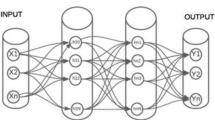Abstract
Since the past decades, internet usage has become inevitable due to its tremendous applications in various fields. Due to this huge usage of network, a lot of security problems arise. Intrusion detection system (IDS) monitors the network events and filters the abnormal activities. While monitoring events, large amount of data samples are collected from sensors and the features are extracted from raw data which are required for IDS classification. This selection of best features from the raw data can be performed by the optimal feature selection method. To compute the detection accuracy, SVM classifier is used. The proposed model is tested using KDD99 benchmark dataset. Compared to other machine learning algorithm, the proposed method produced better results.













Similar content being viewed by others
Change history
28 September 2023
A Correction to this paper has been published: https://doi.org/10.1007/s42979-023-02168-3
References
Chen YH, Abraham A, Yang B. Hybrid flexible neural-tree based intrusion detection systems. Int J Intell Syst. 2007;22(4):337–52.
Wang G, Hao J, Ma J, Huang L. A new approach to intrusion detection using Artificial Neural Networks and fuzzy clustering. Expert Syst Appl. 2010;37(9):6225–32.
. Xiao T, Qu G, Hariri S, Yousif M. An efficient network intrusion detection method based on information theory and genetic algorithm. In: Proceedings of the 24th IEEE international performance computing and communications conference (IPCCC 2005), Hoenix, AZ, USA, 2005
Kruegel TC, Toth T. Using decision trees to improve signature based intrusion detection. In: Proceedings of the 6th international workshop on the recent advances in intrusion detection (RAID 2003), vol 2820, 2003, pp. 173–191.
Ambusaidi MA, Tan Z. Building an intrusion detection system using a filter-based feature selection algorithm. IEEE Trans Comput. 2014
Tama BA, Rhee KH. A combination of pso-based feature selection and tree-based classifiers ensemble for intrusion detection systems. In: Park et al. D-S (eds) Advances in computer science and ubiquitous computing, lecture notes in electrical engineering 373. Springer Science+Business Media, Singapore (2015)
Rathi B, Jadhav DV. Network intrusion detection using PSO based on adaptive mutation and genetic algorithm. Int J Sci Eng Res 2014;5(8).
Amudha P, Karthik S. A hybrid swarm intelligence algorithm for intrusion detection using significant features. Sci World J. 2015
Ma J, Liu X, Liu S. A new intrusion detection method based on BPSO-SVM. In: Proceedings of the international symposium on computational intelligence and design (ISCID2008), vol 1, 2008, pp. 473–477.
Aburomman DA, Mamun. A novel SVM-kNN-PSO ensemble method for intrusion detection system. Applied Soft computing. Amsterdam: Elsevier; 2015.
Mirjalili S, Mirjalili SM, Yang X-S. Binary bat algorithm. Neural computer and applications. Berlin: Springer; 2014.
Yang X-S. Bat algorithm: literature review and applications. Int J Bio-Inspired Comput. 2013;5(3):141–9.
Yang X-S, Costa KA, Rodrigues D. A binary bat algorithm for feature selection. Researchgate puplication, 2016.
Kennedy J, Eberhart RC. Particle swarm optimization. In: IEEE international conference on neural network, 1995, pp. 1942–194
Darigo M, Birattari M, Stutzle T. Ant colony optimization. IEEE Comput Intell Mag. 2006;1:28–39.
Li LX, Shao ZJ, Qian JX. An optimizing method based on autonomous animate: fish swarm algorithm. Proc Syst Eng Theory Pract. 2002;11:32–8.
Khadidos AO, Manoharan H, Selvarajan S, Khadidos AO, et al. A classy multifacet clustering and fused optimization based classification methodologies for SCADA security. In: Energies, MDPI, 2022, https://doi.org/10.3390/en15103624
Shitharth S, Kshirsagar PR, Praveen Kumar B, Khaled, Omar A. An innovative perceptual pigeon galvanized optimization (PPGO) based likelihood Naïve Bayes (LNB) classification approach for network intrusion detection system. IEEE Access 2022;10: 46424–46441. https://doi.org/10.1109/ACCESS.2022.3171660
Shitharth S, Prasad KM, Sangeetha K, Kshirsagar PR, Babu TS, Alhelou HH. An enriched RPCO-BCNN mechanisms for attack detection and classification in SCADA systems. IEEE Access. 2021;9:156297–312. https://doi.org/10.1109/ACCESS.2021.3129053.
Shitharth S, Satheesh N, Praveen Kumar B, Sangeetha K. IDS detection based on optimization based on WI-CS and GNN algorithm in SCADA network. In: Architectural wireless networks solutions and security issues, lecture notes in network and systems, Springer, Singapore, 2021; vol. 196, no. 1, pp. 247–266. https://doi.org/10.1007/978-981-16-0386-0_14
Funding
The authors declare that they have no conflict of interest.
Author information
Authors and Affiliations
Corresponding author
Additional information
Publisher's Note
Springer Nature remains neutral with regard to jurisdictional claims in published maps and institutional affiliations.
This article is part of the topical collection “Computational Statistics” guest edited by Anish Gupta, Mike Hinchey, Vincenzo Puri, Zeev Zalevsky and Wan Abdul Rahim.
Rights and permissions
Springer Nature or its licensor (e.g. a society or other partner) holds exclusive rights to this article under a publishing agreement with the author(s) or other rightsholder(s); author self-archiving of the accepted manuscript version of this article is solely governed by the terms of such publishing agreement and applicable law.
About this article
Cite this article
Prashanth, S.K., Shitharth, S., Praveen Kumar, B. et al. Optimal Feature Selection Based on Evolutionary Algorithm for Intrusion Detection. SN COMPUT. SCI. 3, 439 (2022). https://doi.org/10.1007/s42979-022-01325-4
Received:
Accepted:
Published:
DOI: https://doi.org/10.1007/s42979-022-01325-4




